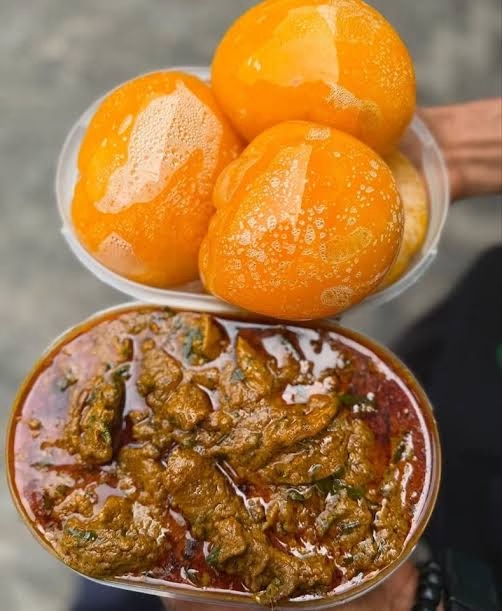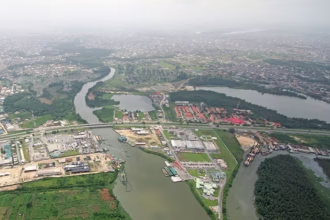Banga soup is the pride of the Niger Delta — a rich, aromatic palm nut soup that’s been warming hearts and filling bellies in Isoko and Urhobo communities for generations. If you’ve been craving that authentic Delta State flavor, this step-by-step guide will show you exactly how to make Banga soup the traditional way.
Doesn’t matter if you’re a seasoned cook or making Banga for the first time, this recipe will have you cooking like a true Deltan in no time!
What is Banga Soup?

Banga soup is a traditional Nigerian soup made from palm fruit extract, special aromatic spices, and assorted meat or fish. It’s native to the Niger Delta region, particularly beloved by the Urhobo and Isoko people of Delta State.
The soup goes by different names depending on the ethnic group:
- Oghwo Amiedi — Urhobo name
- Izuwo Ibiedi — Isoko name
- Ofe Akwu — Igbo version (different spices, served with rice)
- Abak Atama — Efik version
What makes Delta-style Banga soup unique is the special combination of aromatic spices that give it that distinctive taste and aroma you can’t find anywhere else. The soup is traditionally served in a clay pot called Evwere and paired with Starch (Usi)—the perfect swallow that slides down effortlessly.
Ingredients for Banga Soup
For the Palm Nut Extract:

- 10 cups fresh palm fruits (Banga seeds) OR 1 large can of palm nut concentrate
Protein Options (choose your combination):
- 1 kg assorted meat (beef, shaki/tripe, cow leg, ponmo)
- 1 medium fresh catfish (cleaned and cut into steaks)
- Stockfish (soaked and softened)
- Dry fish (washed and deboned)
- 1 cup fresh prawns/shrimps
- 1 cup periwinkles (shelled) — optional
- Smoked turkey or chicken — optional
The Essential Banga Spices:
- 1-2 teaspoons Ataiko (aromatic seeds)
- 1-2 teaspoons Irugeje/Rogoje (tiny aromatic seeds)
- 1 Oburunbebe stick (Banga stick/African licorice stick)
- 2 tablespoons crushed Beletientien leaves (Obeletientien)
Pro Tip: You can buy pre-mixed Banga spice from the market if you can’t find individual spices.
Other Ingredients:
- 3 tablespoons ground crayfish
- 6-8 Scotch bonnet peppers (Ata rodo) — blended or whole
- 1-2 teaspoons Cameroon pepper (dry pepper)
- 1 medium onion (diced)
- 2-3 seasoning cubes
- Salt to taste
Equipment You’ll Need
- Large pot for cooking
- Mortar and pestle (if using fresh palm fruits)
- Sieve or strainer
- Evwere (traditional clay pot) for serving — optional but authentic
- Wooden spoon
Step-by-Step Instructions
Step 1: Prepare the Palm Nut Extract
If using fresh palm fruits:
- Wash the palm fruits thoroughly to remove dirt
- Boil in water for 20-30 minutes until the skin softens
- Drain and transfer to a mortar
- Pound gently to separate the flesh from the nuts (don’t break the kernels)
- Add warm water and squeeze out the thick, orange juice
- Strain through a sieve to remove the chaff
- You should have about 7-10 cups of thick palm nut extract
If using canned palm nut concentrate: Simply open the can and dilute with warm water to your desired consistency. This saves significant time and effort!
Step 2: Prepare Your Proteins
- Wash and season your assorted meat with salt, onions, and seasoning cubes
- Add water and cook until tender (about 30-45 minutes)
- Add stockfish and cook for another 10 minutes
- If using dry fish, wash and soak in hot water to soften, then set aside
- Pre-cook prawns with a little water, salt, and seasoning cube for 3-5 minutes
- Clean your fresh catfish thoroughly — wash with salt to remove slime, or freeze overnight and rinse when thawed
- Reserve the meat stock for later use
Step 3: Prepare the Banga Spices
- Grind the Ataiko and Irugeje seeds together in a dry mill or blender
- Add the ground crayfish to the spice mix
- Crush the Beletientien leaves (don’t grind too fine)
- Set aside your Oburunbebe stick
Note: If using pre-mixed Banga spice, simply measure out 1-2 tablespoons.
Step 4: Cook the Banga Soup
- Pour the palm nut extract into a large pot and place over medium-high heat
- Add dry fish, stockfish, and ground crayfish to the pot
- Bring to a boil and let it cook for about 5-10 minutes. Do NOT cover the pot, else it will boil over!
- Add the cooked meat along with 1-2 cups of reserved stock
- Drop in the Oburunbebe stick, this adds that distinctive Banga aroma
- Add the ground Banga spices (Ataiko and Irugeje), blended or whole peppers, and Cameroon pepper
- Season with seasoning cubes and salt to taste
- Stir and let it cook for another 10-15 minutes. The soup will start to thicken and you’ll see palm oil rising to the top—this is a good sign!
- Add the fresh catfish gently (don’t stir vigorously or it will break apart)
- Add prawns and periwinkles if using
- Sprinkle the crushed Beletientien leaves over the soup
- Reduce heat to low and let it simmer for 7-10 minutes until the fish is cooked
- Remove the Oburunbebe stick (you can rinse, dry, and reuse it!)
- Taste and adjust seasoning if needed
Your Banga soup is ready!
How to Serve Banga Soup (The Traditional Way)
For the most authentic experience:
- Scoop individual portions into an Evwere (clay pot)
- Place the clay pot directly on low heat
- Let it simmer until the soup thickens further and the edges look slightly caked
- Use a tea towel to carefully slide the hot clay pot onto a tray
- Serve with Starch (Usi or Ozi) alongside
The clay pot keeps the soup hot throughout your meal and thickens it to the perfect consistency!
What to Eat with Banga Soup

Banga soup is best enjoyed with:
- Starch (Usi or Ozi) — the traditional Urhobo/Isoko swallow (most authentic!)
- Eba (garri swallow)
- Pounded yam
- Fufu
- Semolina
- Amala
For the true Delta experience, always go with Starch!
How to Make Starch (Usi or Ozi) — Bonus Recipe!
Starch is a yellow, stretchy, gelatinous swallow made from cassava. It’s THE perfect companion for Banga soup.
Ingredients:
- 2 cups cassava starch
- 4-5 tablespoons palm oil (from the top of your Banga soup works great!)
- Water
- Pinch of salt
Instructions:
- Mix the cassava starch with cold water to form a smooth slurry (no lumps!)
- Boil water in a wide pan or starch pot
- Add palm oil and a pinch of salt to the boiling water
- Pour in the starch slurry while stirring vigorously with a wooden spoon
- Keep stirring as it thickens—it will form clumps first
- Continue stirring and pulling the starch against the sides of the pan
- Work it vigorously until it becomes smooth, translucent, stretchy, and yellow
- Mold into a ball and serve immediately with your Banga soup
Pro Tip: Well-made starch should stretch when you pull it. If it’s too thick, sprinkle a little hot water and keep working it.
Pro Tips for Perfect Banga Soup
- Don’t add too much water — This is the #1 mistake! Your palm nut extract should be thick. Watery Banga soup is disappointing Banga soup.
- Don’t cover the pot — Banga soup will boil over if covered. Use a wooden spoon across the pot to prevent spillovers.
- Add fresh fish last — Catfish cooks quickly and breaks apart easily. Add it towards the end and avoid stirring vigorously.
- Be careful with Banga spice — Too much will make your soup bitter. Start with a little and add more if needed.
- Don’t use thickeners — Never add flour or yam to thicken Banga soup. If it’s watery, remove the meat/fish and boil down the liquid instead.
- Reuse your Oburunbebe stick — After cooking, remove the stick, rinse it well, let it dry, and store in the refrigerator for next time.
- The oil is your friend — The palm oil floating on top is normal and desirable. You can scoop some off to use for making starch!
Banga Soup Spices Explained
Understanding your spices will help you achieve that authentic taste:
| Spice | Local Names | Purpose |
|---|---|---|
| Ataiko | Ataiko seeds | Adds distinctive aroma and flavor |
| Irugeje | Rogoje, Irugege | Works with Ataiko for the signature Banga taste |
| Oburunbebe | Banga stick, African licorice | Adds unique flavor; can be reused |
| Beletientien | Obeletientien, Bush Apple leaves | Garnishing; completes the presentation |
| Aidan fruit | Uyayak, Tyko, Prekese | Optional; adds sweet, fragrant aroma |
Where to find: Ask for “Banga soup spices” at any Nigerian market. The women selling traditional herbs (near zobo and dogoyaro) will have them.
Variations and Substitutions
Protein Variations:
- Fresh Fish Banga — Use only fresh catfish (most popular!)
- Meat Banga — Use assorted beef, goat meat, or bushmeat
- Mixed Banga — Combine meat and fish
- Chicken Banga — Use chicken or smoked turkey
Spice Substitutions (if you can’t find traditional spices):
- Beletientien → Dried bitter leaf, scent leaf, or dried basil
- Oburunbebe → Skip if unavailable (soup will still taste good, just different)
For Diaspora Cooks:
- Use canned palm nut concentrate (saves hours of work!)
- Buy pre-mixed Banga spice online or from African grocery stores
- Frozen catfish works if fresh isn’t available
Nutritional Benefits of Banga Soup
Banga soup isn’t just delicious—it’s nutritious too!
- Palm oil contains antioxidants and has been shown to support heart health
- Fish provides lean protein and omega-3 fatty acids
- Crayfish adds protein and minerals
- Traditional spices have anti-inflammatory properties
- Overall — A balanced meal when paired with starch or other swallows
Common Mistakes to Avoid
❌ Adding too much water (makes soup watery) ❌ Covering the pot while cooking (causes spillover) ❌ Adding too much Banga spice (makes soup bitter) ❌ Stirring vigorously after adding fish (breaks the fish apart) ❌ Using palm oil instead of palm nut extract (completely different!) ❌ Adding thickeners like flour (changes the authentic taste)
Frequently Asked Questions
Is Banga soup the same as Ofe Akwu?
No. While both use palm fruit extract, they use different spices. Banga soup (Delta style) uses Ataiko, Irugeje, Oburunbebe, and Beletientien. Ofe Akwu (Igbo style) uses scent leaves or ugu leaves and is typically served with rice.
Can I make Banga soup without Oburunbebe stick?
Yes, but the taste will be slightly different. The Oburunbebe stick adds a distinctive flavor that’s hard to replicate.
Why is my Banga soup watery?
You either added too much water to your palm nut extract or didn’t cook it long enough. To fix it, remove the meat and fish, then boil the soup over high heat until it thickens.
Can I freeze Banga soup?
Yes! Banga soup freezes well. Store in airtight containers and freeze for up to 3 months. Reheat thoroughly before serving.
Is palm nut extract the same as palm oil?
No! Palm nut extract is unprocessed/unrefined and comes directly from boiled and pounded palm fruits. Palm oil is the refined, red cooking oil. Using regular palm oil will NOT give you authentic Banga soup.
Lastly
Making authentic Banga soup is a labor of love, but the result is absolutely worth it. That first spoonful of perfectly spiced soup with stretchy starch is an experience every food lover should have.
If you’re Urhobo, Isoko, or simply someone who appreciates good food, this recipe will help you create restaurant-quality Banga soup right in your kitchen.
So gather your ingredients, get your clay pot ready, and let’s keep this beautiful Delta tradition alive, one delicious pot at a time!
Have you tried making Banga soup before? Share your experience in the comments below! And if this recipe helped you, please share it with someone who needs to taste authentic Delta cuisine.
Urhobo waado! Isoko waado!













